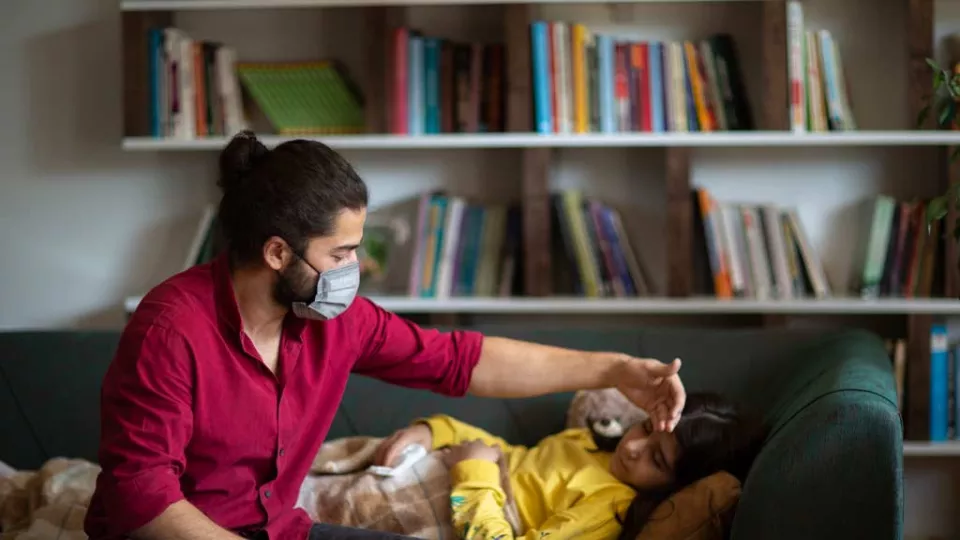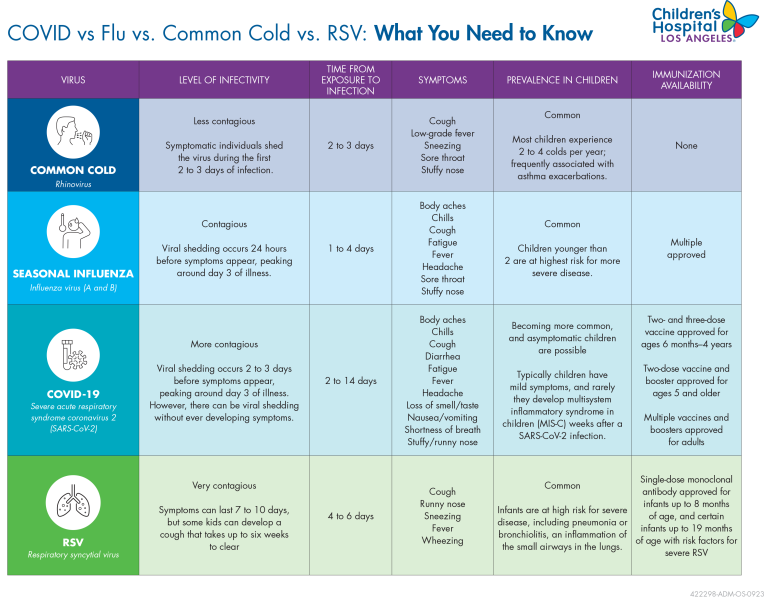
COVID vs. Flu vs. Common Cold vs. RSV: What You Need to Know
September usually marks the start of flu season, and with the ongoing threat of COVID-19, it’s crucial to be vigilant about your family’s health. The challenge, however, is being able to tell the difference between the flu, the common cold, respiratory syncytial virus (RSV) and COVID-19, since all have similar symptoms. So if your child has a fever, sore throat, cough or chills, what should you do?
Find out when to seek medical care, whether it’s possible to have multiple infections at the same time, and the importance of getting the flu vaccine.
What’s the difference between the common cold, the flu, RSV and COVID-19?
They are triggered by different viruses.
- The flu is caused by the influenza virus, which is seen worldwide and has a seasonal cycle in temperate regions, typically starting in the fall and lasting through the spring. It leads to high fevers, coughing, body aches and other respiratory symptoms.
- The common cold, on the other hand, is caused by the rhinovirus and comes with milder symptoms: a runny nose, slight cough. Although everybody experiences illnesses differently, in most cases, if you have a cold you’re still able to function, whereas with the flu you may not.
- RSV, meanwhile, is a result of the respiratory syncytial virus, which can affect the respiratory system, including the nose, throat and lungs. In most people, the virus will present like a cold—a cough, runny nose and sometimes a fever—but in some it can be dangerous. In infants, RSV can cause pneumonia or bronchiolitis, and people over the age of 50 or those with heart or lung disease are also at risk for complications.
- COVID-19 is caused by severe acute respiratory syndrome coronavirus 2 (SARS-CoV-2) and is more serious because of the higher mortality rate. It’s characterized by fevers, cough, runny nose, body aches, and loss of taste and smell. For the most part, children seem to fare much better than adults if they get the coronavirus, but families should still be extra cautious.
If your child has any of these symptoms, you will want to discuss with your pediatrician whether testing is recommended; for example, if you have any high-risk family members at home. Regardless of whether or not you think this is COVID-19, if your child is having difficulty breathing, is unresponsive, or is unable to eat or drink, seek immediate medical care.

With such similar symptoms, is there a more definitive way to tell if someone has the cold, the flu, RSV or COVID-19?
Unfortunately not without testing, and that is the challenge. With COVID-19, it appears that symptoms last longer and some individuals may experience fatigue and anosmia—a loss of smell and taste—that can persist for weeks. But for the most part, only testing can determine whether you have coronavirus or not.
Is it possible to have the cold, the flu, RSV or COVID-19 at the same time?
There have been some reports about people being infected with two concurrently. We do know that all of these viruses have the potential to shed for a long time, so it may be true that someone could test positive for both COVID-19 and RSV, but RSV is the only one causing symptoms. There’s not enough research or cases to truly understand these scenarios yet.
If you do get the flu, cold or RSV, are you more susceptible to COVID-19?
It’s unlikely that just because you got the flu or RSV you’re more at risk for getting coronavirus or some other viral illness. What you’re exposed to is what you get. With any viral illness, you can develop complications such as bacterial pneumonia, which isn’t spread person to person but is caused by your own bacteria.
Why is getting the flu shot especially important for children?
The American Academy of Pediatrics, the Centers for Disease Control and Prevention, and the Infectious Diseases Society of America all recommend that everyone over 6 months of age get the flu vaccine every year. This is especially important in the setting of COVID-19.
All the things we have been doing—washing our hands, physically distancing, wearing masks—are great for preventing the spread of the flu as well. The flu vaccine may not prevent you from getting the flu, but it does an amazing job at helping to prevent you from getting very ill, especially in younger kids who are at high risk for having more severe complications with the flu. Why not add another layer of protection by getting the flu vaccine? We should be doing everything we can to protect our children.
Is there an optimal time to get the flu shot?
As soon as it’s available, you should get it. Every year, the flu vaccine is created so that the immunity lasts for the whole season. So, if it’s being offered at your clinic, don’t delay. If you wait too long, you run the risk of forgetting or, even worse, getting the flu before you’re immunized.
Should kids stay home after getting the flu shot or COVID vaccine?
This isn’t necessary unless your child has a fever or is feeling unwell. These side effects associated with the vaccines do not typically last beyond 24 to 48 hours. If they do, please have your child seen by their pediatrician as the persistent fever is unlikely to be vaccine related.
With the COVID-19 vaccine now available for children 6 months of age and up, do parents need to space apart that vaccine with the flu shot?
There have been many studies that have shown the flu shot can be given at the same time as the COVID vaccine without problems. If both are available, just get them done the same day.
What should be top-of-mind for parents right now?
The main takeaway is that we should all be doing our best to look after our children, our families and each other. Whether that’s getting the flu and COVID vaccines, washing our hands, maintaining physical distancing or wearing our masks, there are tangible measures we can take to protect children in our community.


